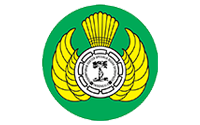UNSTABLE LUMBAR FRACTURE-DISLOCATION TREATED BY LONG SEGMENT POSTERIOR PEDICLE SCREW INSTRUMENTATION
Downloads
Background: Among all the thoracolumbar fractures, 50-60% affects the thoracolumbar transitional zone, and 51% AO Type C Fractures has a neurological deficit. We experienced treating a case of unstable lumbar fracture-dislocation treated with long segment pedicle screw instrumentation.
Case: A 26-year-old man came to the ER after his back hit by a canopy while working 2 hours before admission. The motoric function was diminished from the L2-S1 level and hypoesthesia at the T12 level. Plain X-Ray showed Fracture-Dislocation Lumbar Vertebral 1-2 Denis Classification Flexion Rotation (AO Type C) ASIA A. The patient underwent reduction, decompression, and long-segment posterior pedicle screw instrumentation.
Discussion: The surgery's primary purpose is to restore alignment and stability to improve the patient's quality of life by enabling daily activity in a wheelchair without significant pain. Short segment or long segment pedicle screw instrumentation remains a debate. In this case report, we apply long segment pedicle screw instrumentation for lumbar vertebral fracture-dislocation.
Conclusion: Thoracolumbar fracture and dislocation fixation aim to restore alignment and stability, to reduce kyphotic deformity, and to decompress the spinal canal. The long segment pedicle screw instrumentation can resist the deforming force of thoracolumbar fractures and dislocations that will inevitably collapse into further kyphosis, resulting in a better outcome.
Green DP. Rockwood and Green's fractures in adults. Lippincott williams & wilkins; 2010.
Ahuja CS, Wilson JR, Nori S, Kotter M, Druschel C, Curt A, Fehlings MG. Traumatic spinal cord injury. Nature reviews Disease primers. 2017 Apr 27;3(1):1-21.
Katsuura Y, Osborn JM, Cason GW. The epidemiology of thoracolumbar trauma: A meta-analysis. J Orthop. 2016; 13: 383–8.
Knop C, Blauth M, Bühren V, et al. Operative Behandlung von Verletzungen des thorakolumbalen Übergangs. Unfallchirurg. 1999; 102: 924–35.
Kim BG, Dan JM, Shin DE. Treatment of thoracolumbar Fracture. Asian Spine J. 2015; 9: 133–46.
Deng Z, Zou H, Cai L, et al. The retrospective analysis of posterior short-segment pedicle instrumentation without fusion for thoracolumbar burst fracture with neurological deficit. Sci World J. 2014; 2014: 1–9.
Aly TA. Short segment versus long segment pedicle screws fixation in management of thoracolumbar burst fractures: Meta-analysis. Asian Spine J. 2017; 11: 150–60.
Kim G-W, Jang J-W, Hur H, et al. Predictive factors for a kyphosis recurrence following short-segment pedicle screw fixation including fractured vertebral body in unstable thoracolumbar burst fractures. J Korean Neurosurg Soc. 2014; 56: 230–6.
Ugras A, Akyilidiz M, Yilmaz M, et al. Is it possible to save one lumbar segment in the treatment of thoracolumbar fractures ? Eur J Orthop Surg Traumatol. 2012; 78: 87–93.
Li J, Liu L. Comparison of short-segment versus long-segment fixation for the treatment of thoracolumbar burst fracture: A meta-analysis. Int J Clin Exp Med. 2017; 10: 1750–62.
McLain RF. The biomechanics of long versus short fixation for thoracolumbar spine fractures. Spine. 2006; 31: S70–9.
Raheem HQR. Comparison between short and long segment posterior spinal fixation in thoracolumbar burst fractures. Mustansiriya Med J. 2018; 15 (1): 45-8.
Copyright (c) 2020 JOINTS (Journal Orthopaedi and Traumatology Surabaya)

This work is licensed under a Creative Commons Attribution-NonCommercial-ShareAlike 4.0 International License.
- The author acknowledges that the copyright of the article is transferred to the Journal of Orthopaedi and Traumatology Surabaya (JOINTS), whilst the author retains the moral right to the publication.
- The legal formal aspect of journal publication accessibility refers to Creative Commons Attribution-Non Commercial-Share Alike 4.0 International License (CC BY-NC-SA).
- All published manuscripts, whether in print or electronic form, are open access for educational, research, library purposes, and non-commercial uses. In addition to the aims mentioned above, the editorial board is not liable for any potential violations of copyright laws.
- The form to submit the manuscript's authenticity and copyright statement can be downloaded here.
Journal of Orthopaedi and Traumatology Surabaya (JOINTS) is licensed under a Creative Commons Attribution-Non Commercial-Share Alike 4.0 International License.



























 Journal Orthopaedi and Traumatology Surabaya (JOINTS) (
Journal Orthopaedi and Traumatology Surabaya (JOINTS) (